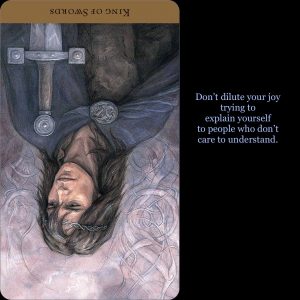I love reversals. People who don’t use them insist that all the possible meanings are in a card, upright or not, but that’s a huge load to make a card (or reader) carry.
By including reversals, I only have to see half of that stuff at a time.

Reversals have been read a number of ways:
- Something opposite the core meaning
- The worst version of the card topic
- a smaller or specific aspect of the card
- intensifying the core meaning
- in protection aspect (kind warning)
- delay or resistance to the topic/essence
- fear related to the topic of the card, or placement in the spread.
- Not at all (every reader chooses for themselves, and have all of these element still available to them).
There are more, of course, but these are the ones I’ve run into personally.
How do you know which one it is?
Context (as you will hear from me over and over in this blog) is everything.

I pulled the unicorn above (a reversed 2 of pentacles), and thought about how I see all the 2s as blessings – often abundance. The protection aspect (#5, above) was the first thing that jumped to mind, and I sat with those puzzle pieces for a bit to reach my words.

With this reversed king of swords, I felt like he was almost his upright self, which one observation alone rules out a number of the options above.
We can say cards have a personality, and sometimes it changes between decks, just like a favorite bible or classic of literature can feel very different in one form or another.
When turned upside-down, I questioned the type of communication I might normally attribute to this king. Instead of communication-outward, it was filtering, checking the readiness of the listener before investing the time.
(That’s the short version of this card’s #HowIgotThere – follow my Facebook page to see more or more in-depth).
This reading could be seen as a combination reversal-reading types: Numbers 1, 3, and 6, for example: An opposite, a specific focus of meaning, and a delay or resistance to the normal (communications) interpretation.
~ ~ ~
As to skipping reversals altogether, that’s fine, too. You can just turn them upright as you lay out the cards.
There’s even a cool trick to this with way more decks than I used to realize.
A lot of decks have very subtle (or not) differences in their card backs. It can fall on a spectrum of visibility. A shading difference takes practice to notice. A different number or placement of stars is slightly less subtle. A graphic that isn’t reversible is the most blatant of all, and some decks are designed not to be read reversed (tho you always have the choice).
If the person laying out the card knows to watch for these, they can change how you turn or flip the cards so they show upright as you lay them out.

And here we have something that might look really scary. An exploding planet, right? Doesn’t get worse than that, right?
Well, again, it depends on you.
If you approach the tarot with fear, expecting the worst, it’s possible it wouldn’t matter what card showed up.
A lot of people divide the tarot deck into cards that are “good” and “bad.”
A lot of people do that with life, too.
They say there’s only two kinds of people in the world: Those who divide people into two groups, and those who don’t.
But one of the reasons tarot is a gift is that very little of our world is split-able into binary. Tarot takes that complexity and mirrors it back to us in a way (I hope, and I practice) that lets us practice finding the good.
If you have a practice of drawing a card each day to think about (a recommended way to get familiar with your deck), give yourself this challenge:
Whatever meaning you find for the card you drew, look for a way to let it enrich your life (edification) or comfort your heart (encouragement).
When I pulled that exploding planet I sat with it for a while. I considered what I knew the card to mean in different contexts, and I considered what had been going on in my life that day.
I gave myself something that helped me to slow down.
It was a reversal, and it was good.